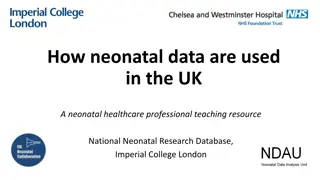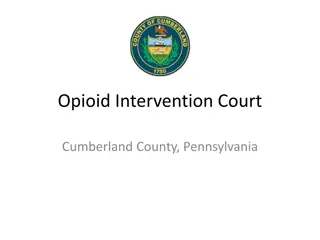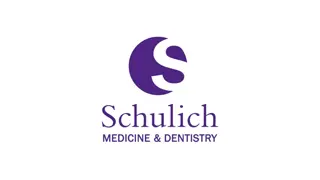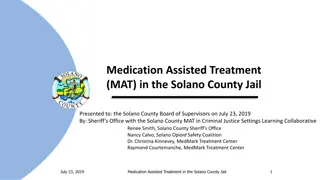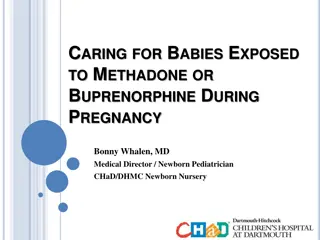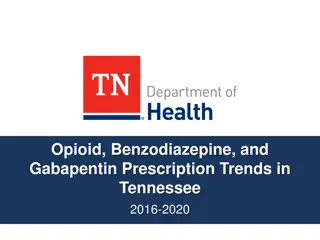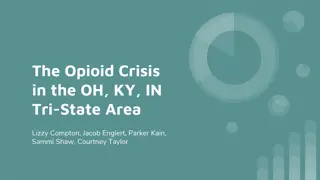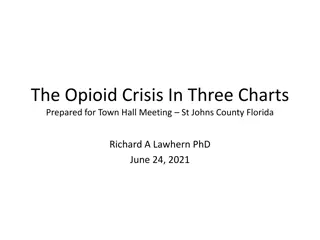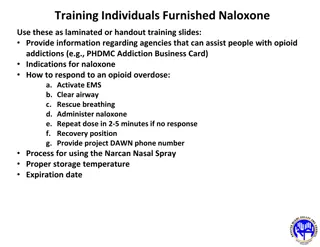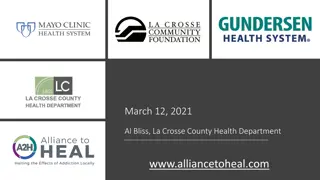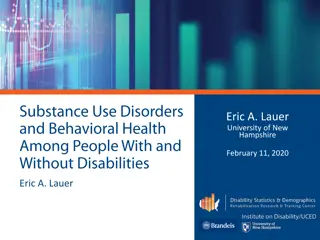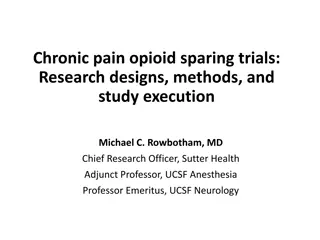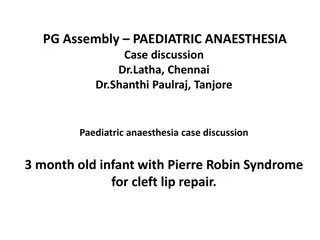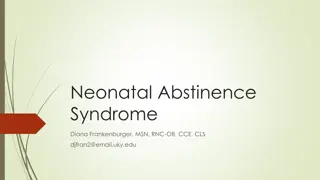Understanding Neonatal Abstinence Syndrome (NAS) and Opioid Crisis Impact
Neonatal Abstinence Syndrome (NAS) is a condition where infants experience withdrawal symptoms from exposure to drugs in utero, with a significant impact seen in regions like southeastern Kentucky due to the opioid crisis. This syndrome manifests through various short and long-term effects, necessitating both pharmacological and nonpharmacological interventions for optimal management and support.
Download Presentation

Please find below an Image/Link to download the presentation.
The content on the website is provided AS IS for your information and personal use only. It may not be sold, licensed, or shared on other websites without obtaining consent from the author. Download presentation by click this link. If you encounter any issues during the download, it is possible that the publisher has removed the file from their server.
E N D
Presentation Transcript
Neonatal Abstinence Syndrome Diana Frankenburger, MSN, RNC-OB, CCE, CLS
Learning Objectives Participant will be able to define Neonatal Abstinence Syndrome (NAS) and recognize its symptoms Participants will be understand potential short and long term effects of NAS Participants will be able to state initial nonpharmacological and pharmacological interventions for treatment of infants with NAS Participants will be able to state potential supportive measures for children and parents through early childhood
The Opioid Crisis 2017: US Department of Health and Human Service (HHS): opioid crisis in America is a public health emergency 11.1 million Americans misused prescription meds 47,872 deaths from unintentional overdose 2.6 million had opioid use disorder Use of heroin and pain medications by women nearly doubled since 2009 Delivery records indicate quadrupling of opioid use disorder since 1999 (Kondili & Duryea, 2019)
Result of Opioid Exposure Increase in health care spending for prolonged hospitalizations 50-80% of exposed infants develop NAS symptoms Symptoms begin 24-48 hours Symptoms can last up to 60 days
Rate of NAS in southeastern Kentucky is approximately three times higher than the statewide rate.
Definition of NAS (Neonatal Abstinence Syndrome) NAS can be characterized as an infant s response to withdrawal of prescribed or illicit medications or substances they were exposed to in utero. This withdrawal may be potentiated by other medications or substances including nicotine and caffeine. This response is evaluated using one of several scoring tools, most popular being Finnegan Neonatal Abstinence Scoring Tool. Scoring involves evaluating how the infant functions in specific areas and scores response from normal to mild, moderate, or severe dysfunction. (Reddy, et al.,2017)
Areas of Short-term Dysfunction and Symptoms with NAS Central Nervous System (high pitched cry, irritability, hypertonia, hyperreflexia, difficulty sleeping) Gastrointestinal System (disorganized swallow and suck, poor feeding, weight loss, loose stools, spitting up) Autonomic Nervous System (hyperthermia, nasal stuffiness, sweating, sneezing, mottling, yawning, tachypnea)
Symptoms of changes in neurotransmitters after loss of opioid supply Dopamine decrease Hyperirritability Anxiety Noradrenaline Increase Hyperthermia Hypertension Tremors Tachycardia Serotonin decrease Sleep deprivation Sleep fragmentation Acetylcholine Increase Diarrhea Vomiting Yawning Sneezing Sweating (Kocherlakota, 2014)
NAS Crying J:\Kathy's Medical Presentations\Medical Presentation 2011 0902\irritable baby.jpg
When Should Treatment for NAS Begin? Evaluation begins with symptoms Usually appear within 72 hours of birth Scoring every 3-4 hours Scoring >8 in 3 consecutive scorings/ >12 in two consecutive scorings Length of stay for evaluation: 5 days (Kondili & Duryea, 2019) (ACOG, 2017)
Why Treat Women with Opioid Agonists? Prevents opioid withdrawal symptoms Decreases use of non-medical opioids Improves adherence to prenatal care In combination with prenatal care, decreases risk of OB Complications: Decreases risk of IUGR, abruption, preterm labor, fetal death Decreases participation in high-risk behaviors, STIs, violence Decreases risk of relapse during pregnancy (ACOG Committee Opinion Number 711, 2017)
What About Medically Supervised Withdrawal? Associated with higher relapse rates (59-90%) Poorer pregnancy outcomes Accidental overdose due to loss of tolerance Higher obstetrical complications Increased fetal stress or death Decreased adherence to prenatal care/ lost to care Often requires prolonged inpatient care or intensive outpatient care (ACOG Committee Opinion Number 711, 2017)
Responsible Care Obstetricians must use screening tools to evaluate all patients for SUD Obstetricians must be educated on the risks and benefits of Opioid Agonist Therapy during pregnancy AND MUST EDUCATE THEIR PATIENTS Methadone: prescribed by Addiction Medicine Specialist in licensed outpatient setting with daily dosing/dispensing Patients stable on Methadone should continue it Dosage may require adjustment during pregnancy Buprenorphine/Buprenorphine with naloxone: prescribed by OB Care Provider with specialized training Can be self-administered, prescribed in office setting, stigma Buprenorphine has increased street value/potential for diversion. Buprenorphine with naloxone safe in pregnancy because is given sublingually (dangerous to fetus if injected) Naltrexone is not currently recommended in pregnancy Risk of NAS symptoms exist with Opioid Agonist Therapy-must be communicated (ACOG Committee Opinion Number 711, 2017),(Reddy, et al., 2017)
Non-Pharmacological Supports Breastfeeding when appropriate (ACOG, ABM) Rooming in (AAP, ACOG) Maternal involvement- Bonding and Attachment Skin to skin (Kangaroo Care) Infant massage, positioning 5 Ss Soothing Techniques https://www.youtube.com/watch?v=crdQy8zliZw (Kondili & Duryea, 2019)
Prenatal Support for Mothers: PATHways Stabilization of Addiction Prenatal Care and Education Group and Individual Therapy Social Service Support Peer Support NAS Symptom Reduction training Breastfeeding encouragement Smoking Reduction/Cessation
Impact of Group Prenatal Sessions For every prenatal session attended, a patient was 13-18% more likely to have a negative screen for illicit drugs on admission (Adams, 2017). Tracking patients progress though educational offerings Incentives for completion Involvement of Hospital staff (Neonatologists, PTs, RNs, IBCLCs, Music Therapist) Empowers women to have tools for assisting infants through withdrawal. Gives them knowledge and decreases fear/anxiety about how to help
Symptoms of NAS (Neonatal Abstinence Syndrome) and Ways to Soothe Baby It can be hard to know what to do to calm your baby. Below are some common symptoms of NAS, and ways you can help your baby through them. Tremors: disturbed/undisturbed- swaddling your baby between care. Always have baby sleep on her back, but you can swaddle her and hold her against your stomach while you sway, or on her side with her on your lap while you sit in a chair. Not sleeping between feedings (at least 1 hour after feed)- use skin to skin, lower lights and have a quiet environment, or use white noise or other repetitive sounds- there are apps for this. Sounds babies like include vacuum cleaner, babbling brook, wind, etc. See what your baby responds to. Then keep this on while she sleeps. Temperature over 99.3- remove extra blankets or clothing layers. Try to keep baby dressed like you so she doesn t get overheated. Vomiting of whole feed or projectile vomiting- burp your baby often and give no more than an ounce at a time between burps. Pace feeding: this means tilt the bottle to give a small amount, then once baby swallows this, give a small amount more. Use smaller more frequent feedings. Positioning: try sitting baby up further to feed. If breastfeeding, try another position, and allow plenty of time for feeds. If you are formula feeding, use a slower flow nipple on the bottle. Watery diarrhea or loose stools-NO WIPES, use 4x4s and water to clean and aquaphor or hydraphor for a moisture barrier. Excoriation (skin breakdown)- NO WIPES, use 4x4s and water to clean and use aquaphor or hydraphor for a moisture barrier. High pitched cry-Try music therapy, white noise or other repetitive sounds- there are apps for this. (see not sleeping between feeds). Also try swaddling, rocking, swinging, or skin to skin. Inability to self soothe or be consoled for over 5 minutes- use swaddling, rocking, swinging, skin to skin, white noise. Increased muscle tone- try massaging your baby, using firm but gentle touch. Also use a lavender scent lotion. Or you can practice skin to skin. Excessive suck- Use a pacifier. Poor feeding-pace feeding (see how to above), smaller more frequent feeds, try slower flow nipple. Breastfeeding if appropriate. Please Remember: Your baby is comforted most by being with you. If you can stay with your baby in the hospital throughout her stay, that will always be best. It helps to have a partner to support you while you stay with your baby, so that you can g
Breastfeeding Women who have appropriate drug screens are encouraged to breastfeed (ABM Protocol, 2015) Breastfeeding decreases NAS symptoms (Kondili & Duryea, 2019). Breastfed infants are less likely to require medication for withdrawal (Kondili & Duryea, 2019). Women who have relapsed in the 30 days prior to delivery should not breastfeed (ABM Protocol, 2015). Women who have relapsed in 30-90 days prior should be evaluated case by case (ABM Protocol, 2015) Breastfeeding reinforces sobriety, bonding, and self-esteem. The biggest benefit is likely skin to skin contact and participation in care at the bedside (Saia, et al., 2016).
Hospital Support: Keeping Moms and Babies Together Staff trained in Trauma-Informed Care Nurses receive ongoing training/evaluation in Finnegan Scoring Rooming In Nurses teach/encourage non-pharmacological soothing techniques: skin to skin, swaddling, white noise, swaying, rocking, pacifiers, calm environment Lactation Consultants for Breastfeeding Avoid alcohol wipes (use water wipes or 4x4s with sterile water; Aquaphor for breakdown) Encourage Safe Sleep environments/practices Dedicated Unit/Space/Staff for NAS Care by Parent
Why Care By Parent? AAP states first line of therapy for babies being evaluated for NAS is non- pharmacological supportive care (Highleyman, L., 2017). Studies using Rooming-in models that keep mothers and infants together have found a decrease in the number of infants requiring pharmacological treatment and a decrease in infants length of stay (Knopf, 2018). Rooming-in increases breastfeeding rates, decreases need for medication for NAS, and cuts average cost of treatment by 50%. (Knopf, 2018),(McQueen, 2018).
Pharmacological Supports Morphine: (average Length of Stay (LOS) 21 days) Methadone: ( average LOS 14-21days) Buprenorphine: (average LOS 9-15 days) Clonidine: adjunctive; may assist in decreasing LOS Phenobarbital: adjunctive; may assist in decreasing LOS (Kondili & Duryea, 2019). Treatment is considered adequate if the infant has rhythmic sleep and feeding cycles and appropriate weight gain (Reddy, et al., 2017).
Short and Long Term Effects: Drugs, Environment, Genetics Like prematurity, issues don t resolve with infancy More studies are needed on long term effects When looking at any information on NAS and its long term effects, the lifestyle, economic, genetic, and social issues surrounding the development of these children have to be considered, whether raised by biological parents or the foster system. Attachment is sometimes very difficult for mothers with SUD, either because of a lack of attachment from their own mothers, not being able to parent their infants from birth, or other struggles in their recovery. Support may be needed mentally and physically through young adulthood. (Oei, 2019).
Continued Support Home Based Visitation Programs (HANDS) Beyond Birth New Vista Voices of Hope Women/infants are often lost to care after delivery, making follow up and continued support difficult. Continued Medically Assisted Treatment until the woman feels ready to cease treatment may allow better accountability and access to healthcare for them and their children.
Beyond Birth Continuation of support/care after PATHways for up to 5 years Parenting Classes approved for DCBS Attorney services Job Prep Services KY Dept of Vocational Rehab GED assistance KY Career Center Group and Individual Therapy Peer Support Medically Assisted Therapy available
It takes a Village Coordinated multisystem approach for pregnant women with SUD Non-pharmacological therapies for NAS must be taught and encouraged Women and families must feel supported and empowered to help their infants during evaluation/ treatment for NAS Continued support and attachment assessment in first year Home-based programs show promise in improving outcomes for children long term with continued resources (Kondili & Duryea, 2019) (Oei, 2019)
References ACOG Committee Opinion (2017). Opioid use and opioid disorder in pregnancy, Number 711. Retrieved from https://www.acog.org/clinical/clinical-guidance/committee-opinion/articles/2017/08/opioid-use- and-opioid-use-disorder-in-pregnancy Adams, E. (2017). PATHways program demonstrates success of evidence-based, collaborative approaches to perinatal opioid treatment. UKnow: University of Kentucky News. Retrieved from: https://uknow.uky.edu/uk-healthcare/pathways-program-demonstrates-success-evidence-based- collaborative-approaches. Casper, T., & Arbour, M. (2014). Evidence-based nurse-driven interventions for the care of newborns with neonatal abstinence syndrome, Advances in Neonatal Care, 14(6): p. 376-380. doi: 10.1097/ANC.0000000000000118. Highleyman, L. (2017). New approaches help babies get through opioid withdrawal, MedPage Today, May 12, 2017. Retrieved from: http://www.medpagetoday.com/meetingcoverage/pas/65259. Knopf, A. (2018) More research needed on NAS, but evidence for breastfeeding and rooming in is clear, Alcoholism and Drug Abuse Weekly, 30(15): 1-3. Retrieved from: http://dx.doi.org.ezproxy.uky.edu/10.1002/adaw.31921 Kocherlakota, P. (2014). Neonatal Abstinence Syndrome, Pediatrics, 134(2): p.e-547-e-561. doi:10.1542/peds.2013-3524 .
References contd Kondili,E. & Duryea,D. (2019) The role of mother-infant bond in neonatal abstinence syndrome (NAS) management, Archives of Psychiatric Nursing, 33(3): p. 267-274. McQueen, K. (2018). Rooming-in could be an effective non-pharmacological treatment for infants with neonatal abstinence syndrome, Evidence Based Nursing. doi: 10.1136/eb-2018- 102948. Oei, J.L.(2019). After NAS, Seminars in Fetal and Neonatal Medicine, 24(2019): 161-165. Retrieved from https://doi.org/10.1016/j.siny.2019.01.012 Reddy, U., Davis, J., Ren, Z., & Green, M. (2017). Opioid use in pregnancy, neonatal abstinence syndrome, and childhood outcomes, Obstetrics & Gynecology, 130:1, p. 10-27. Reece-Stremtan, S., Marinelli, K. (2015). ABM clinical protocol #21: Guidelines for breastfeeding and substance use or substance use disorder, revised 2015, Breastfeeding Medicine, 10(3): 135-141. doi: 10.1089/bfm.2015.9992 Saia,K., Schiff, D., Wachman, E., Mehta, Pl., Vilkins, A., Sia, M., Price, J., Samura, T., DeAngelis, J., Jackson, C., Emmer, S., Shaw, D., & Bagley, S. (2016). Caring for pregnant women with opioid use disorder in the USA: Expanding and improving treatment, Current Obstetrics and Gynecology Report, 5:257-263. doi: 10.1007/s13669-016-0168-9.


